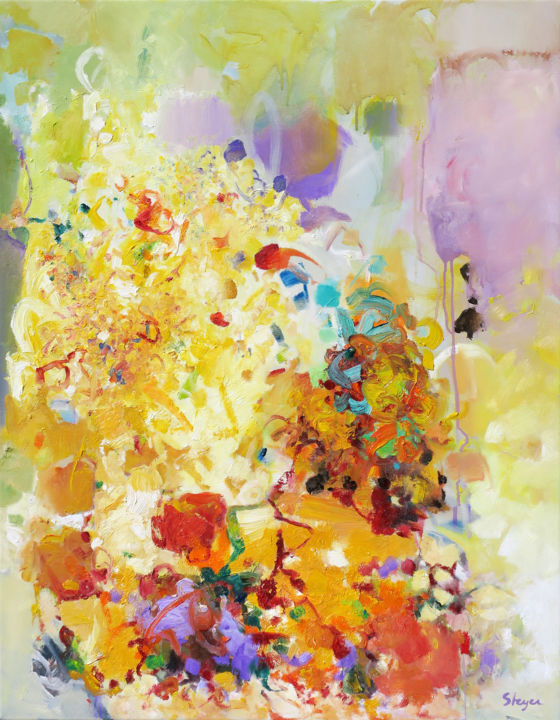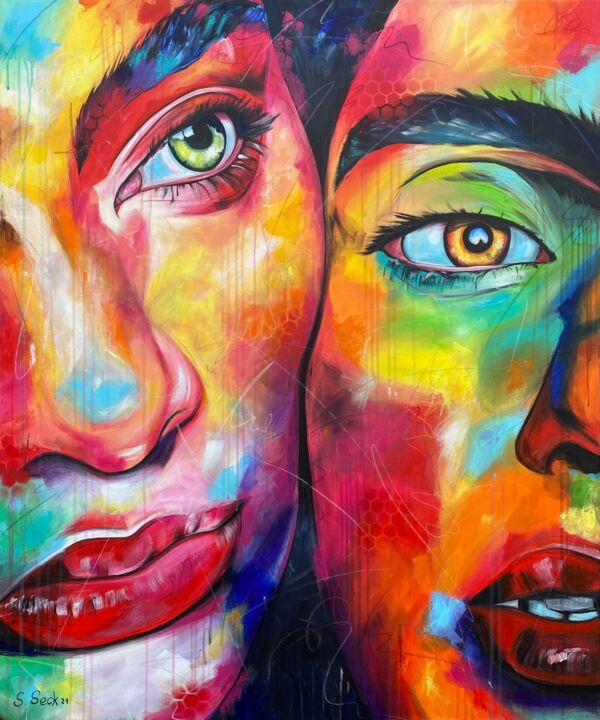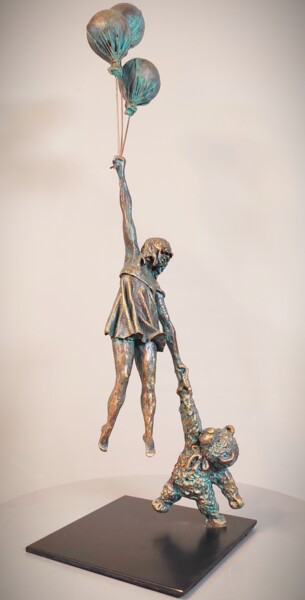 Alexander Friedrich, Vaccinated 1, 2021. Sculpture, acrylic on Metal, 85 x 45 x 30 cm / 8.00 kg.
Alexander Friedrich, Vaccinated 1, 2021. Sculpture, acrylic on Metal, 85 x 45 x 30 cm / 8.00 kg.
Introduction to the History of German Art
The history of German art perfectly exemplifies the ability, and perseverance, of a people who have always wanted to distinguish themselves from the figurative work of neighboring nations. This desire stems from a strong sense of identity and a quest for uniqueness, which, all German, has promoted its artistic heritage as a source of intimate and personal pride. These kinds of ideas have been fortified especially since the 18th century, when Germany, in conflict with its neighbors, strongly felt the need to promote its autonomy. In this context, artists had the duty to preserve their own culture without introducing elements from other scenes or, at least, personalizing them. Subsequently, the most important of these identity theories found their way into the core of the multiple artistic movements, which have crossed Germany in the last centuries.
 Christoph Jakob, Bildsteine_19_k_04, 2019. Sculpture, stone on stone, 25 x 25 x 10 cm / 22.00 kg.
Christoph Jakob, Bildsteine_19_k_04, 2019. Sculpture, stone on stone, 25 x 25 x 10 cm / 22.00 kg.
 Thomas Steyer, The obstacle, 2021. Oil on canvas, 90x70 cm.
Thomas Steyer, The obstacle, 2021. Oil on canvas, 90x70 cm.
The history of German art as told by its most iconic artists
The history of German art can be simply told through the work of some of its greatest masters, who, with their innovations, have indelibly shaped its stylistic features, techniques and subjects of investigation. First among all the innovators of the figurative arts in Germany was certainly Albrecht Dürer, the most important exponent of the German Renaissance. In Germany, this period of exceptional artistic flowering came almost 100 years later than in Italy, since German artists remained faithful to the stylistic features of Gothic and International Gothic art for a long time. Nevertheless, at the beginning of the 16th century German art began to free itself from medieval consciousness, opening itself to the important innovations of Italian art. In this context, the brightest star in the German Renaissance sky was Albrecht Dürer (1471-1528), painter, engraver, printer, mathematician and theorist from Nuremberg. It was precisely his woodcuts, of the highest quality, often referred to as "magisterial prints," that established his reputation and influence throughout Europe, making him regarded as the greatest artist of the Northern Renaissance. In addition, it was through the work of this master that the graphic arts rose to the level of an independent art form.
Albrecht Dürer, Melencolia I, 1514. Engraving, 31 x 26 cm. Karlsruhe: Staatliche Kunsthalle.
As far as German Romanticism is concerned, the first of the "romanticisms" that developed in Europe between the end of the 18th century and the beginning of the 19th, it is important to mention the work of the master Caspar David Friedrich, one of the greatest painters who ever lived, who, respecting the Romantic figurative research, painted above all landscapes, marked by a strong Nordic character and by a feeling of religious quietness. In these compositions often appeared the human figure, which was surprised in the deepest contemplation of the landscape.
Caspar David Friedrich, Wanderer above the Sea of Fog, 1818. Oil on canvas, 95 x 75 cm. Hamburg: Hamburger Kunsthalle.
Otto Dix, Portrait of the journalist Sylvia von Harden, 1926. Oil and tempera on wood, 1.21 m x 89 cm. Paris: Musée National d'Art Moderne, Paris.
Impressionism, the first international artistic movement in the history of European art, emerged in France around 1870. It imposed itself in Germany thanks to the work of some pioneering artists, among whom the particular artistic investigation of the painter Max Liebermann certainly stands out. During the 20th century, however, German art went through many technological and cultural changes, including the two world wars, which led to the development of a wide range of artistic movements. In this rich cultural context, it is important to highlight the impact that the work of artists such as Franz Marc, the leading exponent of German Expressionism, Otto Dix, the most important artist of the Neue Sachlichkeit movement, and Max Ernst, the pioneer of Surrealism and the Dada movement, had. With regard to contemporary reality, it is important to mention the figurative investigation of Gerhard Richter, a multifaceted artist without belonging style, Georg Baselitz, well known for his sexualized portraits, and Andreas Gursky, a photographer with considerable weight on the art market. Finally, it is worth highlighting the work of other influential contemporary German artists, such as Thomas Schütte, Anselm Kiefer, Neo Rauch, Thomas Struth, Rosemarie Trockel, Albert Oehlen, and Günther Uecker.
 Erik Schubert, Baltikum. Oil on canvas, 100 x 80 cm.
Erik Schubert, Baltikum. Oil on canvas, 100 x 80 cm.
 Rudi Eckerle, Gold / Weiss, 2018. Painting, pigments / acrylic on wood, 38 x 38 cm.
Rudi Eckerle, Gold / Weiss, 2018. Painting, pigments / acrylic on wood, 38 x 38 cm.
Artmajeur and some of its most innovative German artists
The uniqueness of German figurative research can also be found in the work of the artists of Artmajeur, and in particular, in the three different points of view expressed by Sabrina Seck, Nikolaus Weiler and Peter Nottrott.
 Sabrina Seck, By my side, 2021. Acrylic / chalk / spray on canvas, 120 x 100 cm.
Sabrina Seck, By my side, 2021. Acrylic / chalk / spray on canvas, 120 x 100 cm.
Sabrina Seck: By my side
Sabrina Seck, born in Wesel (Germany) in 1979, is a German painter and illustrator, whose career, in progress for over twenty years, is characterized by a strong autonomy and experimentation. In fact, the artist expresses herself through different materials and colors, creating very personal figurative works, characterized by strong and intense pop colors. This vital love for color, with which the artist depicts mostly women and animals, allows Seck to express also her interest and respect for nature, promoting its protection. About the work By my side, in this acrylic on canvas is immortalized the intense incomplete close-up of two female figures, who, having their cheeks in sweet "collision" with each other, probably express a strong sense of friendship and solidarity. Finally, the lively chromatism of the painting, which itself generates the features of the women, becomes the undisputed protagonist of the composition together with the subjects in the foreground.
 Nikolaus Weiler, 6HOCH3, 2000. Wooden sculpture on Other substrate, 40 x 55 x 25 cm / 5.80 kg.
Nikolaus Weiler, 6HOCH3, 2000. Wooden sculpture on Other substrate, 40 x 55 x 25 cm / 5.80 kg.
Nikolaus Weiler: 6HOCH3
Nikolaus Weiler is a contemporary German sculptor active in Berlin since 1993. The artist's production is characterized by the creation of "Alldimensionale Skulpturen", that is, sculptures in all dimensions, capable of expanding in space from and towards all sides. It should be noted, however, as this type of work, which "move" in space, are also capable of generating it! In fact, the very forms of Weiler's sculptures give life, within themselves, to new and unprecedented empty spaces. By following this mode of artistic creation, sculpture is definitively freed of its characteristic static nature, generating new dynamism and movement. The complexity of 6HOCH3's intricate embrace of forms is a perfect example of a sculpture that, as it expands into space, also finds a way to accommodate it within, thanks to a wealth of "solids and voids" that is capable of summarizing the essence of the thousand opposing forces in the universe.
 Peter Nottrott, Positive energy XXXL 1 (triptych), 2019. Acrylic on canvas, 240 x 450 cm.
Peter Nottrott, Positive energy XXXL 1 (triptych), 2019. Acrylic on canvas, 240 x 450 cm.
Peter Nottrott: Positive energy XXXL 1 (triptych)
Peter Nottrott, born in 1962 in Flensburg (Germany), is an established German painter who, in a career spanning more than thirty years, has achieved an enormous level of international exposure, so much so that he has become one of the best-selling online artists. The secret to the appeal of his abstract paintings are his energetic and dynamic brushstrokes, which, enriched by the use of vital, high-impact colors, generate a strong emotional response. In fact, his luminous works seem to impose themselves in the visual field of the user as lively "explosions" of color, capable of bringing a strong and immediate charge of optimism. An example of this is the triptych Positive energy XXXL 1, where each of the three canvases contains "fireworks" of color, which, arranged approximately in the center of the canvas, amaze the viewer as in a fireworks display.


 Olimpia Gaia Martinelli
Olimpia Gaia Martinelli























